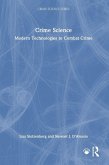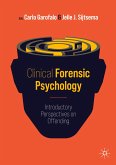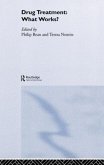- Gebundenes Buch
- Merkliste
- Auf die Merkliste
- Bewerten Bewerten
- Teilen
- Produkt teilen
- Produkterinnerung
- Produkterinnerung
This book shows how to use biopsychosocial assessment for crime prevention and to achieve more individualized treatment for those who commit crimes.
Andere Kunden interessierten sich auch für
![Understanding Crime Prevention Understanding Crime Prevention]() Billy HensonUnderstanding Crime Prevention161,99 €
Billy HensonUnderstanding Crime Prevention161,99 €![Crime Science Crime Science]() Lisa StolzenbergCrime Science176,99 €
Lisa StolzenbergCrime Science176,99 €![Clinical Forensic Psychology Clinical Forensic Psychology]() Clinical Forensic Psychology49,99 €
Clinical Forensic Psychology49,99 €![Drug Treatment Drug Treatment]() Philip Bean / Teresa Nemitz (eds.)Drug Treatment249,99 €
Philip Bean / Teresa Nemitz (eds.)Drug Treatment249,99 €![Environmental Criminology Environmental Criminology]() Martin A. AndresenEnvironmental Criminology172,99 €
Martin A. AndresenEnvironmental Criminology172,99 €![Evolutionary Criminology and Cooperation Evolutionary Criminology and Cooperation]() Evelyn SvingenEvolutionary Criminology and Cooperation83,99 €
Evelyn SvingenEvolutionary Criminology and Cooperation83,99 €![Evolutionary Criminology and Cooperation Evolutionary Criminology and Cooperation]() Evelyn SvingenEvolutionary Criminology and Cooperation83,99 €
Evelyn SvingenEvolutionary Criminology and Cooperation83,99 €-
-
-
This book shows how to use biopsychosocial assessment for crime prevention and to achieve more individualized treatment for those who commit crimes.
Produktdetails
- Produktdetails
- Verlag: Routledge
- Seitenzahl: 280
- Erscheinungstermin: 8. August 2025
- Englisch
- Abmessung: 235mm x 157mm x 20mm
- Gewicht: 560g
- ISBN-13: 9781041078029
- ISBN-10: 1041078021
- Artikelnr.: 73871472
- Herstellerkennzeichnung
- Libri GmbH
- Europaallee 1
- 36244 Bad Hersfeld
- gpsr@libri.de
- Verlag: Routledge
- Seitenzahl: 280
- Erscheinungstermin: 8. August 2025
- Englisch
- Abmessung: 235mm x 157mm x 20mm
- Gewicht: 560g
- ISBN-13: 9781041078029
- ISBN-10: 1041078021
- Artikelnr.: 73871472
- Herstellerkennzeichnung
- Libri GmbH
- Europaallee 1
- 36244 Bad Hersfeld
- gpsr@libri.de
Anthony Walsh is a professor emeritus of criminology at Boise State University. He has taught biosocial criminology, statistics, and philosophy of law there for 34 years. He received his Ph.D. in criminology from Bowling Green State University in 1983. He worked as a marine, merchant seaman, police officer, and probation officer before entering academia at the age of 44. He is widely published, with 55 books and over 150 articles and book chapters on a variety of topics including biosocial aspects of crime and natural theology. He has received the Boise State Foundation Scholar Award for Research and lifetime achievement awards from both the Biosocial Criminology Association and the Biopsychosocial Division of the American Society of Criminology for his research in biosocial criminology. His work has been featured on the Phil Donahue Show, Nova, and Nippon (Japanese) TV.
PART I: Introduction to Crime Prevention and Treatment Policy
Chapter 1. What is Crime Prevention Policy?
PART II: The Biopsychosocial Perspective
Chapter 2. The Biopsychosocial Perspective and Behavioral Genetics
Chapter 3. Molecular Genetics and Antisocial Behavior
Chapter 4. Neurobiology and Antisocial Behavior
Chapter 5. The Social Emotions and Conscience
PART III: Traditional Criminology Theories and Prevention and Treatment
Policies
Chapter 6. Human Ecology/Social Disorganization Theory and Policy
Chapter 7. The Anomie Tradition and Policy
Chapter 8. Subcultural Theories and Poverty
Chapter 9. Social Learning Theories
Chapter 10. Social and Self-Control Theories
PART IV: Specific Syndromes Associated with Criminal Behavior and
Prevention and Treatment Policies
Chapter 11. Attention-Deficit/Hyperactivity Disorder: Causes and Treatment
Chapter 12. Schizophrenia: Causes and Treatment
Chapter 13. Substance Abuse Disorders and Criminal Behavior
Chapter 14. The Microenvironment: Teratogens and Diet
PART V: Traditional and Biopsychosocial Approaches to Assessment and
Treatment
Chapter 15. Correctional Assessment and Treatment Programming
Chapter 16. Biopsychosocial Prevention and Treatment
Chapter 1. What is Crime Prevention Policy?
PART II: The Biopsychosocial Perspective
Chapter 2. The Biopsychosocial Perspective and Behavioral Genetics
Chapter 3. Molecular Genetics and Antisocial Behavior
Chapter 4. Neurobiology and Antisocial Behavior
Chapter 5. The Social Emotions and Conscience
PART III: Traditional Criminology Theories and Prevention and Treatment
Policies
Chapter 6. Human Ecology/Social Disorganization Theory and Policy
Chapter 7. The Anomie Tradition and Policy
Chapter 8. Subcultural Theories and Poverty
Chapter 9. Social Learning Theories
Chapter 10. Social and Self-Control Theories
PART IV: Specific Syndromes Associated with Criminal Behavior and
Prevention and Treatment Policies
Chapter 11. Attention-Deficit/Hyperactivity Disorder: Causes and Treatment
Chapter 12. Schizophrenia: Causes and Treatment
Chapter 13. Substance Abuse Disorders and Criminal Behavior
Chapter 14. The Microenvironment: Teratogens and Diet
PART V: Traditional and Biopsychosocial Approaches to Assessment and
Treatment
Chapter 15. Correctional Assessment and Treatment Programming
Chapter 16. Biopsychosocial Prevention and Treatment
PART I: Introduction to Crime Prevention and Treatment Policy
Chapter 1. What is Crime Prevention Policy?
PART II: The Biopsychosocial Perspective
Chapter 2. The Biopsychosocial Perspective and Behavioral Genetics
Chapter 3. Molecular Genetics and Antisocial Behavior
Chapter 4. Neurobiology and Antisocial Behavior
Chapter 5. The Social Emotions and Conscience
PART III: Traditional Criminology Theories and Prevention and Treatment
Policies
Chapter 6. Human Ecology/Social Disorganization Theory and Policy
Chapter 7. The Anomie Tradition and Policy
Chapter 8. Subcultural Theories and Poverty
Chapter 9. Social Learning Theories
Chapter 10. Social and Self-Control Theories
PART IV: Specific Syndromes Associated with Criminal Behavior and
Prevention and Treatment Policies
Chapter 11. Attention-Deficit/Hyperactivity Disorder: Causes and Treatment
Chapter 12. Schizophrenia: Causes and Treatment
Chapter 13. Substance Abuse Disorders and Criminal Behavior
Chapter 14. The Microenvironment: Teratogens and Diet
PART V: Traditional and Biopsychosocial Approaches to Assessment and
Treatment
Chapter 15. Correctional Assessment and Treatment Programming
Chapter 16. Biopsychosocial Prevention and Treatment
Chapter 1. What is Crime Prevention Policy?
PART II: The Biopsychosocial Perspective
Chapter 2. The Biopsychosocial Perspective and Behavioral Genetics
Chapter 3. Molecular Genetics and Antisocial Behavior
Chapter 4. Neurobiology and Antisocial Behavior
Chapter 5. The Social Emotions and Conscience
PART III: Traditional Criminology Theories and Prevention and Treatment
Policies
Chapter 6. Human Ecology/Social Disorganization Theory and Policy
Chapter 7. The Anomie Tradition and Policy
Chapter 8. Subcultural Theories and Poverty
Chapter 9. Social Learning Theories
Chapter 10. Social and Self-Control Theories
PART IV: Specific Syndromes Associated with Criminal Behavior and
Prevention and Treatment Policies
Chapter 11. Attention-Deficit/Hyperactivity Disorder: Causes and Treatment
Chapter 12. Schizophrenia: Causes and Treatment
Chapter 13. Substance Abuse Disorders and Criminal Behavior
Chapter 14. The Microenvironment: Teratogens and Diet
PART V: Traditional and Biopsychosocial Approaches to Assessment and
Treatment
Chapter 15. Correctional Assessment and Treatment Programming
Chapter 16. Biopsychosocial Prevention and Treatment








